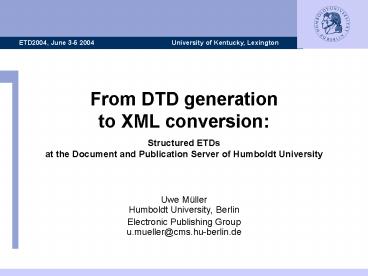From DTD generation to XML conversion: - PowerPoint PPT Presentation
1 / 25
Title:
From DTD generation to XML conversion:
Description:
... EDoc Server ... Structured ETDs at Humboldt's EDoc Server. Conversion Process Using Open ... at Virginia Tech ('ETD'), http://edoc.hu-berlin.de/diml ... – PowerPoint PPT presentation
Number of Views:55
Avg rating:3.0/5.0
Title: From DTD generation to XML conversion:
1
From DTD generation to XML conversion
- Uwe MüllerHumboldt University, Berlin
- Electronic Publishing Groupu.mueller_at_cms.hu-berli
n.de
2
Background
- Humboldt University 800 1.000 dissertations /
year - Germany duty to publish dissertations
- traditional methods
- publishing house
- microfiche
- 40 200 printed copies (depending on faculty
regulations) - Humboldt U. not mandatory to submit an ETD
- ¼ dissertations published electronically
- XML as central strategy
3
Why XML?
- Standardized format
- Long term preservation
- easily convertible to
- presentation formats (HTML, PDF)
- other XML structures
- qualified full text retrieval
- contains structural and contextual information
in a machine readable format
digital signature
Office document
digital signature
XML
digital signature
HTML
4
XML Restrictions to deal with
- XML source does not contain layout information
- rather linear structure
- XML is not used as Authoring System
- authors use their 'own' systems
- Microsoft Word
- LaTeX
- Open Office / Star Office
- Framemaker
- Word Perfect
5
How to overjump the gap?
- get the authors where they are
- instructions and guidelines for authors
- usage of style files (e.g., dissertation-hu.dot)
- manuals, support hotline, regular courses
- different conversion processes
- SGML author (plug in for MS Word lt 97)
- Open Office / Star Office
- exploit genuine XML format
- MS Office 2003
- XML according to DiML DTD
- common pitfalls tables, pictures
6
(No Transcript)
7
Conversion Process Using Open Office
example.doc
front.html
chapter1.html
chapter2.html
Open Office
example.sxw (zip file) . . . . . . . .
chapter3.html
.gif
.jpg
example.html
content.xml
front.xml
example_stl.xml
chapter1.xml
chapter2.xml
chapter3.xml
example.xml
8
(No Transcript)
9
Principal Structure of a DiML document
- ltetdgt
- ltfrontgt..title...author...abstract...lt/frontgt
- ltbodygt
- ltchaptergt
- ltsectiongt
- ...
- lt/bodygt
- ltbackgt..bibliography...appendix...vita...lt/backgt
- lt/etdgt
10
From flat structure to Hierarchy
- only two types of styles in Word
- paragraph styles
- character styles
- e.g., in case of th first occurring Heading 1
paragraph style the converter has to know - Heading 1 is the beginning of a chapter
- Heading 1 implies a head element
- the element chapter can only occur in body
- lt/frontgt
- ltbodygt
- ltchaptergt
- lthead id"anyID"gtIntroductionlt/headgt
11
(No Transcript)
12
(No Transcript)
13
(No Transcript)
14
(No Transcript)
15
(No Transcript)
16
(No Transcript)
17
One Core Multiple Views
- HTML generation (static or dynamic)
- performance problems with XSLT and huge documents
- solution division of XML sources into components
(easier and fast to process) - PDF Print on Demand (http//www.proprint-service
.de) - Current problems
- changing Office systems and versions
- ongoing implementations and adaptations necessary
- but might be restricted to XSL coding
18
Towards a universal DTD?
- DiML originally taken from an SGML DTD at
Virginia Tech ("ETD"), http//edoc.hu-berlin.de/di
ml - already many elements (gt 100)
- combines elements of different description levels
- extended and adapted to local needs
- special requirements from several departments
(e.g., literature / dramatics, humanities,
geography, ) - necessity to include external DTDs (e.g.,
CALS-Table, MathML, MusicML, ) - publication types other than theses and
dissertations - conference proceedings, electronic journals,
other series, - first approach extend DTD aiming at a universal
'mega' DTD - problems complexity, difficult maintenance
- other possibility create a completely new DTD
for each purpose - loss of interoperability
19
Modular DTD Approach
- idea individually adapted DTDs
- split up DTD into modules, such as
- text, structure, citation, dramatics
- handle external DTDs as modules as well, e.g.,
- MathML, MusicML, CALS-Table
- recombine a DTD out of user selected modules
- result
- a DTD with only the needed elements and modules
- individual reference and sample documents
20
Modular DTD Approach Benefits
- modules are easily maintainable
- distributed development
- version numbers for each module
- reusability
- define (several) styles for each module
- reference information for each module
- support different languages
- get a DTD that exactly fits your needs
21
DTDSys Principal Architecture
- modules small packages of elements belonging to
each other - stored in separate files in the DTDBase
- include metadata, e.g., descriptive information,
version numbers, and dependences to other modules - DTDSys generates DTD and reference files using
- XSL / XSLT
- Java
- Web Interfaces
22
Modules and Dependences
- text br, em, strong, sup, sub, u, tt, pre
- common p, head, caption, url, name, foreign
- structure chapter, section, subsection
- citation quotations and references
- documents page numbers, footnotes, endnotes,
- diml front, body, back, abstract
23
DTD Generation Process
XSL
dependences.html
xdiml.dtd
DTDBase
XSL
XSL
selection.xml
full-dtd.xml
module-text.xml
module-text.xml
XSL
module-text.xml
reference . . . . .
dtd-reference.xml
- including
- element info
- description
- dependences
p.php
JavaXSL
chapter.php
24
Outlook
- SCOPE Service Core for Open Publishing
Environments - development of Publication Components (authoring
tools, conversion mechanisms, layout and style
definitions) - management system to maintain versions and
dependences - publication system
- workflow component
- Long Term Preservation activities
- Implementation of OAIS reference model
- Sun Center of Excellence
25
Thanks
- to Sabine Henneberger, Jakob Voß, Matthias Schulz
- Thank you!
- Questions?
- u.mueller_at_cms.hu-berlin.de
- http//edoc.hu-berlin.de/































